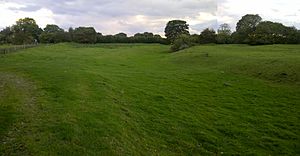Ashton Keynes Castle facts for kids
Ashton Keynes Castle was an old castle located in the village of Ashton Keynes. This village is close to the town of Cricklade in Wiltshire, England. People sometimes call it Hall's Close. Locals even have a nickname for it: The Battlefield. Today, what's left of the castle is a special protected site called a scheduled monument. It mainly consists of two parts: a ringwork and a bailey. These parts are about 100 meters west of Kentend Farm.
Contents
History of the Castle
Who Built Ashton Keynes Castle?
The castle was first built in the 12th century. It was created by a powerful family known as the Keynes family. They were important people in the area at that time.
What Did the Castle Look Like?
When experts dug up parts of the castle, they found out how it was built. It had a main circular area called a ringwork. Next to it was a single, somewhat rectangular area called a bailey. Today, the remains of the castle look a bit worn down. However, in 1959, a small dig showed it once had a strong outer wall. This wall was around the ringwork. A ditch filled with spring water surrounded the wall. This ditch was also strengthened with timber and lined with clay.
Castle's Role During The Anarchy
The way the castle ruins look suggests it was a mix between two types of castles. These were a ringwork and a motte-and-bailey castle. Some historians believe this means it was the castle captured by King Stephen. This happened during a difficult time in English history called the Anarchy. King Stephen took it from a nobleman named Miles of Gloucester.
What Was Found at the Site?
Archaeologists like G.M. Knocker have dug at the castle site. They found many interesting items. These included floor tiles and different types of pottery. Some pottery was glazed, meaning it had a shiny coating. Other pieces were unglazed. These items date from the early 12th century to the 13th century. The discoveries, along with the castle's design, suggest something important. The castle was likely used for military purposes for only a short time. After that, the de Keynes family probably turned it into a manor house. A manor house was a large country house, often the center of a large estate.


